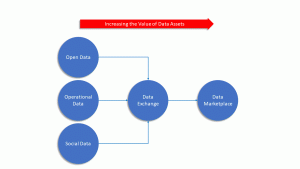Creating value from joined-up IoT data
Look around an airport, a city or a factory and you will see many opportunities for IoT applications. Look deeper and you’ll see numerous clusters of data, some well used and many others underexploited.
Taking the case of a city, one cluster corresponds to open data. These are published data sets that provide citizens with access to information about local services. Or statistics about crime and performance levels for public services, for example.
A second category of data-driven applications applies to operational challenges. Many cities deploy operational support applications to manage city resources; think of smart street parking or bus and bicycle-sharing services. Other operation-style applications include management of a city’s workforce to optimize waste collection or street maintenance activities.
Data from social media feeds represent a third category of data. By monitoring and responding via such feeds, a city can respond to citizen needs while keeping track of the sentiments expressed by local residents and tourists.
As the design and deployment of IoT matures as a discipline, organizations will consolidate their management of applications and data across these three categories. This will drive economies of scale and cost efficiencies from using application hosting technologies and IT expertise. In due course, this type of consolidation will create new application opportunities. City departments will find it easier to collaborate. And application developers will find new uses from joining up IoT data from different silos.
Smart cities: Data-sharing framework
In a recent white paper, the Alliance for Telecommunications Industry Solutions (ATIS) analyzed the transition that smart cities will experience as they make greater use of city assets and data. ATIS’ report, “Smart Cities: Data Sharing Framework,” explains how cities are likely to consolidate data from the three categories — open, operational and social — into a data exchange. A data exchange is essentially a technical framework for bringing data together from multiple sources. A data exchange makes it easier for application providers to weave together data and applications in order to work across inter-organizational boundaries.
The data exchange concept, however, only goes so far in using the value of data. This is because it satisfies the needs of one group of users, the individual departments with a local government agency, and their smart city application priorities. A far more interesting prospect is to tap into a wider ecosystem of innovators and users. These are individuals and organizations that will approach the challenge from different angles. They will tackle other service needs and look for other sources of value from city data assets. As a proxy for this, consider how some organizations collaborate with service provider partners or academic institutions to inject new ideas, explore new application opportunities and use expertise that they lack in-house.
By extending the multiparty concept to a much larger scale, ATIS identifies the improvements necessary to progress from a data exchange to a data marketplace. The latter is where public and private sector organizations can collaborate to combine and trade data with a view to building new applications. Just like a real work marketplace, the data marketplace provides common rules of engagement for all parties. Ideally, it should have low barriers to entry, encouraging innovators and startups to participate. It should also rely on an agreed set of commercialization and data licensing protocols. Having these elements in place will ensure a smooth running business environment for all concerned.
All IoT Agenda network contributors are responsible for the content and accuracy of their posts. Opinions are of the writers and do not necessarily convey the thoughts of IoT Agenda.

